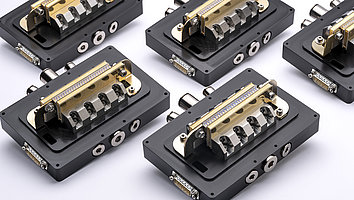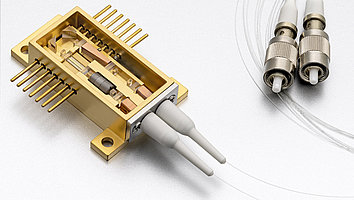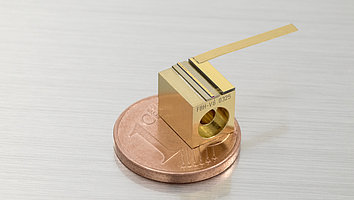FBH presents its advanced semiconductor light sources at Photonics West 2023
The Ferdinand-Braun-Institut (FBH) will present its developments and advancements in diode lasers and UV light-emitting diodes (LEDs) in person at Photonics West 2023, San Francisco (USA). The FBH is both represented at the exhibition and contributes to the accompanying conferences (28 January - 2 February 2023) with 19 scientific presentations. At the German Pavilion, booth 4105-55 (31 January - 2 February 2023), the institute showcases its full range of capabilities from design through chips to modules and prototype systems. In addition to its established diode-laser-based light sources, the FBH exhibits at the booth their latest progress in high-power kilowatt-class pump modules, which the institute is currently scaling from pulsed into continuous wave mode operation and from emission at wavelengths around 1 µm into longer wavelengths around 1.5 µm. FBH also presents its LED-based irradiation systems. Equipped with inhouse developed UVC LEDs, the system can be used for the disinfection of surfaces and directly on the skin, for example, to eradicate multi-resistant pathogens such as MRSA and MSSA as well as further bacteria and viruses.
Further exhibits at the booth comprise:
Compact fiber-coupled amplifier modules – from NIR to visible spectral range
The FBH has developed compact fiber-coupled amplifier modules delivering several hundred-milliwatt CW output power through polarization-maintaining single-mode fibers. These modules have been designed for super-resolution microscopy but can be flexibly adjusted to further applications. The semiconductor-based amplifier systems are optionally available with nonlinear crystals to achieve visible laser output emission through second harmonic generation. To provide the necessary seed power, any arbitrary fiber-coupled laser source can be used. From only 50 mW input power at 1122 nm, for example, more than 450 mW output power is achieved. With the integrated nonlinear crystal, more than 200 mW output power is provided at 561 nm under the same input power conditions, meeting the requirements, for example, of super-resolution microscopy. All variants share the same butterfly-type packages with a footprint of only 47 x 34 mm² and industrial standard fiber connectors. The concept is not limited to a specific wavelength, and amplified output emission at nearly any wavelength in the range between 630 nm and 1180 nm can be realized.
Red DBR laser chips for strontium-based optical atomic clocks
Optical atomic clocks provide the most accurate time measurements available so far and have the potential to benefit basic research as well as improve satellite navigation. For strontium optical atomic clocks, FBH scientists developed red-emitting distributed Bragg reflector (DBR) lasers with emission wavelengths from 689 nm to 712 nm. The frequency stability with a record spectral linewidth of only 0.4 MHz makes the lasers suitable for laser cooling, repumping and excitation of the clock transition.
In DBR lasers, a ridge waveguide ensures lateral single-mode operation. Frequency stability and specificity of the emission frequency are enforced by a surface Bragg grating at one end of the laser diode. Incorporating the grating into the chip yields smaller and more compact lasers than comparable systems with external gratings, making DBR lasers ideal candidates for space applications of quantum optical sensors.
Particularly robust & compact – monolithically integrated Extended Cavity Diode Laser (mECDL)
The FBH presents ongoing research activities in transferring the hybrid micro-integrated concept of GaAs-based narrow-linewidth extended cavity diode lasers (ECDLs) onto a single chip. This novel monolithically integrated ECDL (mECDL) is based on an innovated 2-step growth process. The concept can be adopted to realize mECDLs at different wavelengths.
Ultra-narrow linewidth AlGaAs/GaAs-based mECDLs emitting at 1064 nm (for iodine spectroscopy) and 778 nm (for 2-photon rubidium spectroscopy) have already been successfully demonstrated. Monolithic integration increases the thermal and mechanical stability of the lasers and allows for cost-effective production of wafer-level lasers for space-borne applications of quantum photonics.


